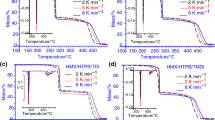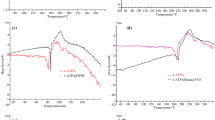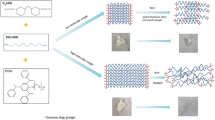Abstract
A polyester (PE)-based polyurethane (PU) is widely used as a polymeric binder with an energetic compound especially more energetic octhydro-1,3,5,7 tetranitro-1,3,5,7 tetrazocine (HMX) in many energetic composite formulation. Compatibility between PE-based PU containing various curatives and HMX was studied through vacuum stability test, thermogravimetry and differential scanning calorimetry methods. PUs were obtained from the reaction of the prepolymer PE with various diisocyanates as curatives especially 4,4′ methylenediphenyl diisocyanate (MDI), isophorone diisocyanate (IPDI), toluene diisocyanate (TDI) and 2,2,4 trimethylhexamethylene diisocyanate (TMDI), and these PUs were designated by PE/MDI, PE/IPDI, PE/TDI and PE/TMDI, respectively. The compatibility was judged through standardization agreement (STANAG) 4147. The results showed that the binary mixture of HMX with various PU, namely PE/MDI, PE/IPDI, PE/TDI and PE/TMDI, possessed a good compatibility. Kinetics of the binary mixture of HMX and PU was studied at three heating rates by means of the Ozawa and Kissinger methods. The calculated activation energy values of the binary mixture of HMX with PE/MDI, PE/IPDI, PE/TDI and PE/TMDI from the Kissinger method were found to be 483.9, 504.7, 502.2 and 485.3 kJ mol−1, respectively. For comparison, the values of neat PE and HMX were also calculated and were 118.2 and 299.3 kJ mol−1, respectively. The kinetic parameters were strongly depended on the type of the curative groups in the PE-based PU. Similar results were obtained from the Ozawa and ASTM E698 methods. The activation energy values calculated from the ASTM E698 method for the HMX/PE/MDI, HMX/PE/IPDI, HMX/PE/TDI and HMX/PE/TMDI samples were 204–215, 219–235, 145–157 and 172–246 kJ mol−1 in the low conversion of 0.05–0.15, respectively. Subsequently, these were demonstrated by a remarkable deviation in the activation energy in a range of 247–474, 235–499, 166–578 and 245–528 kJ mol−1 at the conversion (0.15–0.95), respectively.










Similar content being viewed by others
References
Wang J, Chen S, Jin S, Shu Q, Zhang X, Shi R. Thermal behavior, compatibility study and safety assessment of diammonium 5,5′-bistetrazole-1,1′-diolate (ABTOX). Therm Anal Calorim. 2019. https://doi.org/10.1007/s10973-019-08605-x.
Tseng JM, Lin CP, Huang ST, Hsu J. Kinetic and safety parameters analysis for 1,1,-di-(tert-butylperoxy)-3,3,5-trimethylcyclohexane in isothermal and non-isothermal conditions. J Hazard Mater. 2011;192:1427–36.
Lu YM, Liu SH, Shu CM. Evaluation of thermal hazards based on thermokinetic parameters of 2-(1-cyano-1-methylethyl)azocarboxamide by ARC and DSC. J Therm Anal Calorim. 2019. https://doi.org/10.1007/s10973-019-08827-z.
Wei CY, Lin WC, Pan XH, Shu CM, Hua M, Jiang HC, Jiang JC. Thermal risk assessment of tert-butylperoxy-2-ethylhexyl carbonate for storage and transport. J Therm Anal Calorim. 2019. https://doi.org/10.1007/s10973-019-08552.
Niu H, Chen SS, Jin SH, Li BJ, Li X, Wang JF, Ma X, Bao F, Li LJ. Preparation, nonisothermal decomposition kinetics, heat capacity and safety parameters of TKX-50-based PBX. J Therm Anal Calorim. 2018;131:3193–9.
Villar LD, Cicaglioni T, Diniz MF, Takahashi MFK, Rezende LC. Thermal aging of HTPB/IPDI-based polyurethane as a function of NCO/OH ratio. Mater Res. 2011;14:372–5.
Li X, Lin QH, Peng JH, Wang BL. Compatibility study between 2,6-diamino-3,5-dinitropyrazine-1-oxide and some high explosives by thermal and nonthermal techniques. J Therm Anal Calorim. 2017;127:2225–31.
Chen JB, Guo T, Lu HL, Song XD, Zheng W, Pei JF, Zhang C, Huang XC. Compatibility study of dihydroxylammonium 3,3′-dinitroamino-4,4′-azoxyfurazanate with some energetic materials applied in solid propellant. J Therm Anal Calorim. 2017;130:891–7.
Singh A, Kaur G, Sarkar C, Mukherjee N. Investigations on chemical, thermal decomposition behaviour, kinetics, reaction mechanism and thermodynamic properties of aged TATB. Cent Eur J Energ Mater. 2018;15:258–82.
Zeman S, Elbeih A, Yan QL. Notes on the use of vacuum stability test in the study of initiation reactivity of attractive cyclic nitramines in the C-4 matrix. J Therm Anal Calorim. 2013;112:1433–7.
Malotky L, Heller H. Explosive compatible polymers for defense application. J Hazard Mater. 1978;2:189–95.
EK S, Dudek K, Johansson J, Latypov N. Scale-up and characterization of 3,4-dintropyrazole (DNP) for its use as melt- cast matrix. In: Proceedings of new trends in research of energetic materials. Pardubice; 2014.
Santhosh G, Ang HG. Compatibility of ammonium dinitramide with polymeric binders studied by thermoanalytical methods. Int J Energ Mater Chem Propuls. 2010;9:27–41.
Klerk WA, Schrader MC, Van der Steen A. Compatibility testing of energetic materials, which technique ? J Therm Anal Calorim. 1999;56:1123–31.
Mazzeu MAC, Da Costa ME, Iha K. Studies on compatibility of energetic materials by thermal methods. J Aerosp Technol Manag. 2010;2:53–8.
Stankovic M, Dimic M, Blagojevic M, Petrovic S, Mijin D. Compatibility examination of explosive and polymer materials by thermal methods. Sci Tech Rev. 2003;3:1–10.
STANAG 4147 (2 ed). Chemical compatibility of ammonium components with explosives (non-nuclear applications); 2001.
Myburgh A. Standardization on STANAG test methods for ease of compatibility and thermal studies. J Therm Anal Calorim. 2006;85:135–9.
Zuo YF, FudeN Y, Tian X, Zou JH, Liu SJ. Thermal behaviors of NTO-based PBXs and their compatibilities with metals. Chin J Energ Mater. 2009;17:55–63.
Yan QL, Li XJ, Zhang LY, Li JZ, Li HL, Liu ZR. Compatibility study of trans -1,4,5,8-tetranitro-1,4,5,8-tetraazadecalin (TNAD) with some energetic components and inert materials. J Hazard Mater. 2008;160:529–34.
Pang WQ, Fan XZ, Xue YN, Xu HX, Zhang W, Zhang XH, Li YH, Li Y, Shi XB. Study on the compatibility of tetraethylammonium decahydrodecaborate (BHN) with some energetic components and inert materials. Propellants Explos Pyrotech. 2013;38:278–85.
Huang H, Shi Y, Yang J, Li B. Compatibility study of dihydroxylammonium 5,5′-bistetrazole-1,1′diolate (TKX-50) with some energetic materials and inert materials. J Energ Mater. 2015;33:66–72.
Li X, Wang BL, Lin QH. Compatibility study of 2,6-diamino-3,5-dinitropyridine-1-oxide with some energetic materials. Cent Eur J Energ Mater. 2016;13:978–88.
Kim HJ, Kwon Y, Kim CK. Thermal and mechanical properties of hydroxyl-terminated polybutadiene-based polyurethane/polyhedral oligomeric silsesquioxane nanocomposites plasticized with DOA. J Nanosci Nanotechnol. 2013;13:577–81.
Elbeih A, Mohamed AE, Tamer E. Application of vacuum stability test to determine thermal decomposition kinetics of nitramines bonded by polyurethane matrix. Acta Astronaut. 2017;132:124–30.
Lemos MA, Bohn MA. DMA of polyester-based polyurethane elastomers for composite rocket propellants containing different energetic plasticizers. J Therm Anal Calorim. 2018;131:595–600.
Singh A, Soni PK, Shekharam T, Srivastava A. A study on thermal behaviour of a poly(VDF-CTFE) copolymers binder for high energy materials. J Appl Polym Sci. 2013;127:1751–7.
Singh A, Singh S, Sharma TC, Kishore P. Physicochemical properties and kinetic analysis for some fluoropolymers by differential scanning calorimetry. Polym Bull. 2018;75:2315–38.
Singh A, Kishore P, Singh M, Srivastava A. Changes in the structural and thermal properties of poly(vinylidene fluoride–chlorotrifluoroethylene) irradiated with 4 MeV protons. Radiat Eff Def Solids. 2015;70:845–53.
Singh A, Soni PK, Singh M, Srivastava A. Thermal degradation, kinetic and correlation models of poly(vinylidene-fluoride–chlorotrifluoroethylene) copolymers. Thermochim Acta. 2012;548:88–92.
Allan D, Daly J, Liggat JJ. Thermal volatilization analysis of TDI -based flexible polyurethanes foam. Polym Degrad Stab. 2013;98:535–41.
Rosu D, Tudorachi N, Rosu L. Investigations on thermal stability of a MDI based polyurethane elastomer. J Appl Polym Sci. 2010;89:152–8.
Sekkar V, Venkatachalam S, Ninan KN. Rheokinetic studies on the formation of urethane networks based on hydroxyl terminated polybutadiene. Eur Polym J. 2002;38:169–78.
Gligorijevic N, Zivkovic S, Subotic S, Pavkovic B, Nikolic M, Kozomara S, Rodic V. Mechanical properties of HTPB composite propellants in the initial period of service life. Sci Tech Rev. 2014;64:8–16.
Colclough ME, Desai H, Millar WR, Paul NC, Stewart MJ, Golding P. Energetic polymers as binders in composite propellants and explosives. Polym Adv Technol. 1994;5:554–60.
Agrawal JP. High energy materials, propellants, explosives and pyrotechnics. Weinheim: Wiley; 2015.
Kim HJ, Kwon Y, Kim CK. Synthesis and properties of hydroxyl-terminated polybutadiene-based polyurethanes reinforced with polyhedral oligomeric silsesquioxanes. J Nanosci Nanotechnol. 2014;14:8671–7.
Kim HJ, Kim CK, Kwon Y. Ablation and fire-retardant properties of hydroxyl-terminated polybutadiene-based polyurethane-g-polyhedral oligomeric silsesquioxane composites. High Perform Polym. 2015;27:749–57.
Haska SB, Bayramli E, Pekel F, Özkar S. Mechanical properties of HTPB-IPDI-based elastomers. J Appl Polym Sci. 1996;64:2347–54.
Patil PR, Krishnamurthy VN, Joshi SS. Differential scanning calorimetric study of HTPB based composite propellants in presence of nanoferric oxide. Propellants Explos Pyrotech. 2006;31:442–6.
Mark HF, Gaylord NG. Encyclopedia of polymer science and technology, vol. 12. New York: Interscience Publishers; 1970. p. 105–36.
Singh A, Kumar R, Soni PK, Singh V. Compatibility and thermokinetics studies of octahydro- 1,3,5,7-tetranitro-1,3,5,7-tetrazocine with polyether-based polyurethane containing different curatives. J Energ Mater. 2019;37:141–53.
Yan QL, Zeman S, Elbeih A. Thermal behavior and decomposition kinetics of Viton A bonded explosives containing attractive cyclic nitramines. Thermochim Acta. 2013;562:56–64.
Yan QL, Zeman S, Zhang TL, Elbeih A. Nonisothermal decomposition behaviour of Fluorel bonded explosives containing attractive cyclic nitramines. Thermochim Acta. 2013;574:10–8.
Yan QL, Zeman S, Elbeih A, Zbynek A. The influence of the semtex matrix on the thermal behavior and decomposition kinetics of cyclic nitramines. Cent Eur J Energ Mater. 2013;10:509–28.
Zeman S, Elbeih A, Yan QL. Note on the use of the vacuum stability test in the study of initiation reactivity of attractive cyclic nitramines in Formex P1 matrix. J Therm Anal Calorim. 2013;111:1503–6.
Singh A, Sharma TC, Kishore P. Thermal degradation kinetics and reaction models of 1,3,5-triamino-2,4,6-trinitrobenzene-based plastic-bonded explosives containing fluoropolymer matrices. J Therm Anal Calorim. 2017;129:1403–14.
Singh A, Soni PK, Sarkar C, Mukherjee N. Thermal reactivity of aluminized polymer bonded explosives based on non-isothermal thermogravimetry and calorimetry measurements. J Therm Anal Calorim. 2019;136:1021–35.
Ozawa T. A new method of analyzing thermogravimetric data. Bull Chem Soc Jpn. 1965;38:1881–6.
Kissinger HE. Reaction kinetics in different thermal analysis. Anal Chem. 1957;29:1702–6.
Vyazovkina S, Burnham AK, Criado JM, Perez-Maqueda LA, Pospescu C, Sbirrazzuoli N. ICTAC kinetics committee recommendation for performing kinetic computation on thermal analysis data. Thermochim Acta. 2010;520:1–19.
Chakraborty D, Muller RP, Dasgupta S, Goddard WA. Mechanism for unimolecular decomposition of HMX (1,3,5,7-tetranitro-1,3,5,7-tetrazocine) an Ab Initio study. J Phys Chem A. 2001;105:1302–14.
Lee JS, Hsu CK, Chang CL. A study on thermal decomposition behaviors of PETN, RDX, HNS and HMX. Thermochim Acta. 2002;392:173–6.
Abd-Elghany M, Elbeih A, Hassanein S. Thermal behavior and decomposition kinetics of RDX and RDX/HTPB composition using various techniques and methods. Cent Eur J Energ Mater. 2016;13:714–35.
Singh A, Sharma TC, Narang JK, Kishore P, Srivastava A. Thermal decomposition and kinetics of plastic bonded explosives based on mixture of HMX and TATB with polymer matrices. Def Technol. 2017;13:22–32.
El-Basuony SA, Sadek MA, Wafy RZ, Mostafa HE. Thermokinetic studies of polyurethanes based on hydroxyl terminated polybutadiene prepolymer. J Therm Anal Calorim. 2018;131:2013–9.
Brill TB, Gongwer PE, Williams GK. Thermal decomposition of energetic materials. 66. Kinetic compensation effects in HMX. RDX NTO J Phys Chem. 1994;98:12242–7.
Pinheiro GFM, Lourenco VL, Iha K. Influence of heating rate in the thermal decomposition of HMX. J Therm Anal Calorim. 2002;67:445–52.
Santhosh G, Reshmi S, Nair CPR. Rheokinetic characterization of polyurethane formation in a highly filled composite solid propellant. J Therm Anal Calorim. 2019. https://doi.org/10.1007/s10973-019-08793-6.
Acknowledgements
We express our sincere thanks to Dr. Manjit Singh, Director TBRL for his constant help, guidance and motivation. We are also thankful to Tirupati C Sharma and Mahesh Kumar for their help for thermal analysis.
Author information
Authors and Affiliations
Corresponding author
Additional information
Publisher's Note
Springer Nature remains neutral with regard to jurisdictional claims in published maps and institutional affiliations.
Rights and permissions
About this article
Cite this article
Singh, A., Kumar, R., Soni, P.K. et al. Compatibility and thermal decomposition kinetics between HMX and some polyester-based polyurethanes. J Therm Anal Calorim 143, 3969–3981 (2021). https://doi.org/10.1007/s10973-020-09377-5
Received:
Accepted:
Published:
Issue Date:
DOI: https://doi.org/10.1007/s10973-020-09377-5




